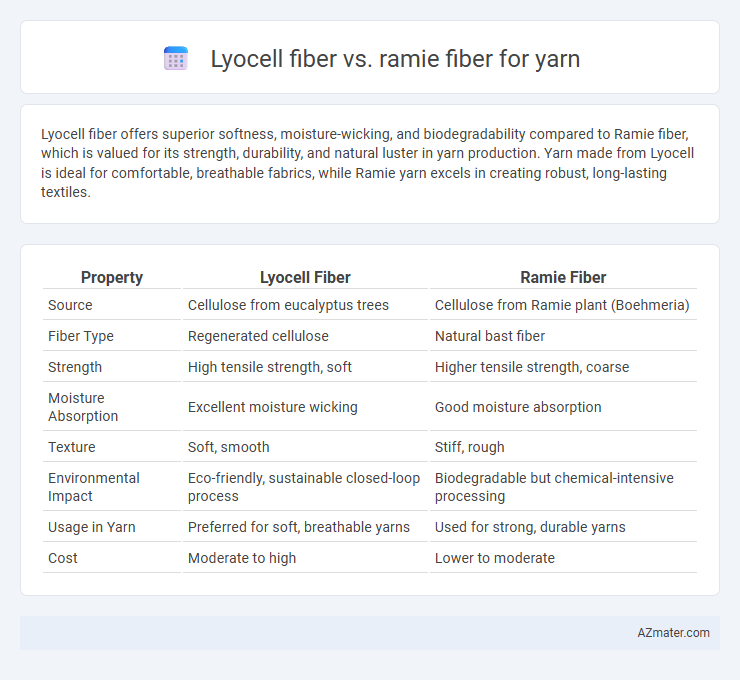Lyocell fiber offers superior softness, moisture-wicking, and biodegradability compared to Ramie fiber, which is valued for its strength, durability, and natural luster in yarn production. Yarn made from Lyocell is ideal for comfortable, breathable fabrics, while Ramie yarn excels in creating robust, long-lasting textiles.
Table of Comparison
| Property | Lyocell Fiber | Ramie Fiber |
|---|---|---|
| Source | Cellulose from eucalyptus trees | Cellulose from Ramie plant (Boehmeria) |
| Fiber Type | Regenerated cellulose | Natural bast fiber |
| Strength | High tensile strength, soft | Higher tensile strength, coarse |
| Moisture Absorption | Excellent moisture wicking | Good moisture absorption |
| Texture | Soft, smooth | Stiff, rough |
| Environmental Impact | Eco-friendly, sustainable closed-loop process | Biodegradable but chemical-intensive processing |
| Usage in Yarn | Preferred for soft, breathable yarns | Used for strong, durable yarns |
| Cost | Moderate to high | Lower to moderate |
Introduction to Lyocell and Ramie Fibers
Lyocell fiber is a sustainable regenerated cellulose fiber made from wood pulp, known for its softness, strength, and moisture-wicking properties, making it ideal for yarn production. Ramie fiber, derived from the stalks of the Ramie plant, is a natural bast fiber prized for its high tensile strength, lustrous appearance, and resistance to bacterial attacks. Both fibers offer eco-friendly alternatives in textile manufacturing, with Lyocell excelling in biodegradability and Ramie providing durability in yarn applications.
Origins and Production Processes
Lyocell fiber is derived from sustainably sourced eucalyptus wood pulp through a closed-loop solvent spinning process that recycles nearly 99% of chemicals and water, minimizing environmental impact. Ramie fiber, originating from the stalks of the native Chinese Ramie plant (Boehmeria nivea), undergoes traditional degumming to remove gummy substances before mechanical processing, which is labor-intensive and time-consuming. The production of Lyocell emphasizes eco-friendly technology and consistent fiber quality, whereas Ramie relies on natural plant cultivation and manual preparation, resulting in a coarser texture suitable for blending in yarn manufacturing.
Physical Properties Comparison
Lyocell fiber exhibits superior tensile strength and elasticity compared to ramie fiber, making it more durable and flexible for yarn applications. Ramie fiber, on the other hand, has higher moisture absorption and better wrinkle resistance but tends to be stiffer and less elastic than lyocell. The smooth, fine structure of lyocell results in softer yarns, while ramie's coarse texture produces yarns with a firmer hand and greater luster.
Environmental Impact and Sustainability
Lyocell fiber, derived from sustainably sourced eucalyptus wood through a closed-loop solvent spinning process, offers superior environmental benefits due to its biodegradability and low water consumption compared to conventional fibers. Ramie fiber, a naturally occurring bast fiber extracted from the stalks of the Boehmeria plant, requires less pesticide use and grows rapidly but involves energy-intensive degumming processes that impact its overall sustainability. Both fibers contribute to eco-friendly yarn production, yet Lyocell's closed-loop manufacturing and renewable raw materials provide a more consistently sustainable option in textile applications.
Yarn Strength and Durability
Lyocell fiber exhibits superior yarn strength and durability compared to Ramie fiber due to its regenerated cellulose structure and high tensile strength, making it ideal for applications requiring sustained wear resistance. Ramie fiber, though naturally strong and resistant to wrinkling, tends to be more brittle and less elastic, which can reduce yarn longevity under stress. The moisture absorption properties of Lyocell also enhance yarn durability by preventing brittleness commonly seen in Ramie fibers during extended use.
Texture and Comfort in Yarn Applications
Lyocell fiber offers a smooth, silky texture with excellent breathability, making it highly comfortable for yarn applications used in garments and textiles requiring moisture-wicking properties. Ramie fiber, known for its coarse and stiff texture, provides strong durability but tends to be less soft and comfortable against the skin compared to Lyocell. Blending Ramie with softer fibers like Lyocell can enhance yarn softness while maintaining strength, optimizing comfort and texture in fabric production.
Dyeability and Color Retention
Lyocell fiber exhibits superior dyeability due to its smooth surface and high moisture absorption, allowing vibrant and even color uptake in yarn production. Ramie fiber, with its crystalline structure, has moderate dye affinity and often requires mordants to enhance color retention in yarns. While Lyocell maintains excellent colorfastness after washing and exposure to light, Ramie tends to fade more quickly, making Lyocell preferable for yarns needing long-lasting vibrant colors.
Moisture Absorption and Breathability
Lyocell fiber exhibits superior moisture absorption and breathability compared to Ramie fiber, making it ideal for yarn used in activewear and summer clothing. Lyocell's moisture absorption rate can reach up to 12%, allowing it to wick sweat away effectively and promote quick drying. Ramie fiber, although breathable and strong, has a lower moisture regain around 11%, resulting in less efficient moisture management in yarn applications.
Cost and Market Availability
Lyocell fiber generally costs more than ramie fiber due to its eco-friendly production process and advanced manufacturing technology, which results in higher market prices. Ramie fiber is more affordable and widely available, especially in regions like China and Southeast Asia, where it is traditionally cultivated and processed. Market availability of lyocell is expanding in sustainable textile sectors, but ramie maintains strong presence in cost-sensitive yarn applications.
Ideal Uses and Consumer Preferences
Lyocell fiber, known for its eco-friendly production and moisture-wicking properties, is ideal for activewear, casual clothing, and high-end fashion due to its softness and breathability. Ramie fiber, prized for its durability, luster, and resistance to bacteria, is preferred in home textiles, upholstery, and blended yarns for added strength and texture. Consumer preferences lean toward Lyocell for comfort and sustainability, while Ramie appeals to those seeking long-lasting, wrinkle-resistant fabric with a natural sheen.

Infographic: Lyocell fiber vs Ramie fiber for Yarn
 azmater.com
azmater.com